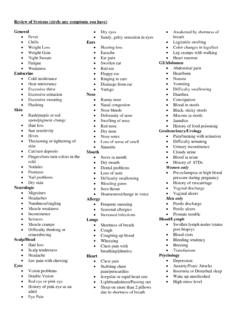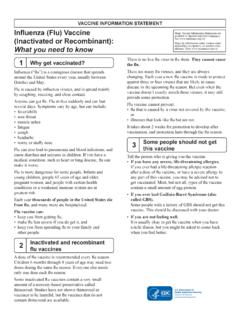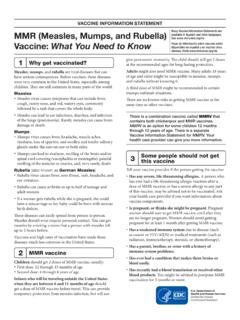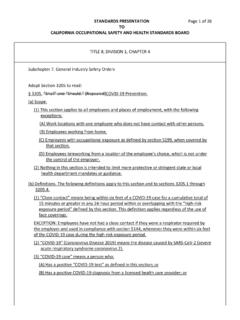Transcription of Abnormal Audiograms in Ear Pathology
1 3/21/20161 Sixth Annual ENT for the PA-C | March 30 April 3, 2016| Orlando, FLAbnormal Audiograms in Ear PathologyPresented by Lori Klingenberg, CCC AEar, nose , throat and Plastic Surgery AssociatesWinter Park, FL Annual ENT for the PA-C | March 30 April 3, 2016| Orlando, FLDisclaimerNone to reportSixth Annual ENT for the PA-C | March 30 April 3, 2016| Orlando, FLObjectives of this sessionThe attendee will Improve interpretation of Audiograms Distinguish ear pathologies with their accompanying Audiograms Narrow the differential diagnosis of hearing loss Recognize the third window phenomenon Identify audiometric findings that suggest non organic hearing loss3/21/20162 Sixth Annual ENT for the PA-C | March 30 April 3, 2016| Orlando, FLAudiogram review Pure tone testing Thresholds are obtained by air and bone conduction. Threshold is determined by at least 2 responses on ascending presentation of tones. Air conduction ONLY tells us the DEGREE of hearing loss Bone conduction tells us what TYPE of hearing loss is present (sensorineural, mixed, conductive) Describe the audiogram by configuration from least amount of hearing loss to the most (ex: mild to severe) Pure tone average is 500 Hz, 1000 Hz, and 2000 Hz added and divided by of hearing lossDegree of hearing loss: 0 15 dB WNL 16 25 dB Slight 26 40 dB Mild 41 55 dB Moderate 56 70 dB Moderately severe 71 90 dB Severe 90+ dB ProfoundMartin and Clark, 2015 Sixth Annual ENT for the PA-C | March 30 April 3, 2016| Orlando, FLMartin and Clark, 20153/21/20163 Sixth Annual ENT for the PA-C | March 30 April 3, 2016| Orlando, FLSpeech TestingSpeech Recognition Threshold The lowest level at which at least 50% of spondees are identified correctly.
2 Purpose=determine the lowest level a person can hear speech. Crosscheck accuracy of pure tone audiometry SRT should be within 7 dB of PTA. Word Recognition (WRs) Percentage of single words or words in sentences patient hears correctly. Purpose=Determining how well the person understands speech in each ear. Used diagnostically and for hearing aid purposes. Lists are presented at suprathresholdSixth Annual ENT for the PA-C | March 30 April 3, 2016| Orlando, FLQuestion 1: do we need it?A. It keeps the worse cochlea from responding with bone It keeps the worse ear from crossover response in air It prevents crossover response in air conduction and bone It focuses the patient s attention away from distracting external Annual ENT for the PA-C | March 30 April 3, 2016| Orlando, do we need it? Prevention of cross hearing in both air conduction and bone conduction Air conduction=If there is a large difference between ears, it is possible the intensity of sound in the test ear could cross over and be heard in the non test ear.
3 Bone conduction=Does not have any inter aural attenuation (0 dB HL)..so without masking the better cochlea is Annual ENT for the PA-C | March 30 April 3, 2016| Orlando, FLTactile responses Important to understand as this may alter treatment method and possibly cause unnecessary surgery Patient feelsthe vibration of bone conduction vs hearingit. Most prevalent at high intensity/low frequency bone conduction (ex: 500 Hz) Why is this an issue? Could cause elevated (better) bone conduction threshold and false referral for surgery to close the air/bone gap. Also ask mature patient if they feltor heardthe sound? Sixth Annual ENT for the PA-C | March 30 April 3, 2016| Orlando, FLVariability in Audiograms Testing outcome can vary based upon: Proper calibration of equipment (done annually) Test environment proper sound booth, minimal extraneous noise Examiner experience Patient (performance on test) False negative or false positive responsesSixth Annual ENT for the PA-C | March 30 April 3, 2016| Orlando, FLAudiometric abbreviations.
4 CNT Could not test DNT Did not test HA Hearing aid HAE Hearing aid evaluation NR No response SNHL Sensorineural hearing loss WNL Within normal limits AU Both sides (ears) AS Left AD Right VT Vibrotactile response RTC Return to clinic BC Bone conduction AC Air conduction PTA Pure tone average UCL Uncomfortable loudness level MCL Most comfortable loudness level HFA High frequency average HL Hearing level SPL Sound pressure level SRT Speech reception threshold SAT Speech awareness threshold (Martin and Clark, 2015)3/21/20165 Sixth Annual ENT for the PA-C | March 30 April 3, 2016| Orlando, FLType of hearing lossAC Loss?BC Loss?SignificantAir/bone gap? CHL= YESNOYESC onductive SNHL= YESYESNOS ensorineural Mixed= YESYESYESMild to severe SNHL, AUMild CHL, AUMild SNHL, ADSevere profound mixed, AS Example AudiogramsSixth Annual ENT for the PA-C | March 30 April 3, 2016| Orlando, FLEar Pathology and Audiograms3/21/20166 Sixth Annual ENT for the PA-C | March 30 April 3, 2016| Orlando, FLLet s start with more Annual ENT for the PA-C | March 30 April 3, 2016| Orlando, FLQuestion 2: Based on this audiogram and knowing the patient had normal tympanometry, what possible disorder could cause this hearing loss, left ear?
5 A. Meniere s diseaseB. Otitis media with effusionC. TM perforationD. OtosclerosisQuestion 3:Based on this audiogram and knowing the patient had normal tympanometry, WHYdo you think the disorder causing this hearing loss, left ear Meniere s because this is low frequency hearing OME because this is conductive hearing TM perf because the SRT is worse on the leftD. Otosclerosis because this is conductive hearing loss with a normal tympanogram3/21/20167 Sixth Annual ENT for the PA-C | March 30 April 3, 2016| Orlando, FLQuestion 4: What type of hearing loss is present, left ear?A. ConductiveB. SensorineuralC. MixedD. Non organicSixth Annual ENT for the PA-C | March 30 April 3, 2016| Orlando, FLQuestion 5: What would be a probable diagnosis?A. Meniere s diseaseB. Large vestibular aqueduct syndromeC. Cochlear otosclerosisD. Sudden idiopathic SNHLS ixth Annual ENT for the PA-C | March 30 April 3, 2016| Orlando, FLIdiopathic SNHL, ASWhat to look for?
6 Decrease in pure tone thresholds of more than 30 dB at 3 consecutive frequencies Asymmetrical SNHL with poor word recognition on affected ear Normal middle ear function Pt may or may not present with vertigo Often present with tinnitus and aural fullness Hearing loss recovery greater for LF thresholds (vs high frequency)3/21/20168 Sixth Annual ENT for the PA-C | March 30 April 3, 2016| Orlando, FLIdiopathic SNHL In many cases, the cause of sudden SNHL cannot be identified. Known causes of sudden SNHL to rule out:Causes? Viral or vascular are most suspected cause (Hall 2014) Perilymph fistula (hearing loss with vestibular symptoms) Autoimmune disorders Meniere s disease (Vestibular symptoms present) Tumors Closed head trauma Rupture of basilar membrane Neurological disordersNoise induced hearing loss NIHL 1 of 2 most common causes of acquired SNHL (the other is presbycusis) Caused by impulsive or long term noise exposure Permissible noise levels=85 dB SPL/8 hours Most preventable cause of acquired hearing loss Landmark noise notch generally around 3 6 kHz Recovery at 8 kHzSixth Annual ENT for the PA-C | March 30 April 3, 2016| Orlando, FLNIHL Temporary threshold shift Decrease in hearing persisting 16 48 hours after exposure (Hall, 2014) Accompanied by tinnitus and distortion of speech Permanent threshold shift Repeated exposure causes irreversible loss characteristic notch around 3 4 kHz.
7 Pattern can widen with continued exposure (Kramer, 2014) Differential Diagnosis? Sudden idiopathic SNHL (case hx and audiometric pattern will differ) Presbycusis (Will not have recovery at 8 kHz as in NIHL) Recommendations? Proper ear protection Antioxidant therapy?3/21/20169 Sixth Annual ENT for the PA-C | March 30 April 3, 2016| Orlando, FLQuestion 6: What disorder(s) would you suspect with this audiogram?A. Presbycusis, AS and Vestibular schwannoma, ADB. Meniere s disease, AD and presbycusis ASC. Bilateral Meniere s diseaseD. Bilateral vestibular schwannomasVestibular SchwannomaSixth Annual ENT for the PA-C | March 30 April 3, 2016| Orlando, FLVestibular Schwannoma According to Hall (2014), autopsy results 8 per 1000 persons. More common in age 30 60 years, females Early stages, high frequency hearing loss as outer fibers of auditory are affected due to compression Tinnitus secondary to tumor pressure Poor word recognition on affected ear (asymmetrical)Right intracanicular cm vestibular schwannoma3/21/201610 Sixth Annual ENT for the PA-C | March 30 April 3, 2016| Orlando, mm left vestibular schwannoma Smaller tumor than previous slide at cm HF asymmetry present, but word recognition remains normal on affected ear.
8 Size and location of tumor causes variance in mm left vestibular schwannomaSixth Annual ENT for the PA-C | March 30 April 3, 2016| Orlando, FLAudiometric findings for vestibular schwannoma red flags Asymmetrical, HF SNHL (progressive with tumor growth) Unilateral tinnitus Pt may not present with vertigo, slow tumor growth results in imbalance due to central compensation Facial tingling or weakness Asymmetrical word recognition with rollover present Abnormal acoustic reflex decay and acoustic reflexes OAEs may be normal if hearing loss is truly neural Normal middle ear function ABR testing=Increased absolute and interpeak (I III) wave latencies. Wave V interaural difference greater than msec. Vestibular testing may show unilateral weakness on affected sideSixth Annual ENT for the PA-C | March 30 April 3, 2016| Orlando, FLDifferential diagnosis of Vestibular Schwannoma s Neurofibromatosis (NF2) Often bilateral symptoms also mistaken for Meniere s disease Meningioma involving auditory nerve (Hall, 2014) Vascular loop syndrome (Hall 2014) Multiple sclerosis (Martin and Clark, 2015) Hx of noise induced hearing loss (asymmetrical due to recreational or work exposure)3/21/201611 Sixth Annual ENT for the PA-C | March 30 April 3, 2016| Orlando, FLQuestion 7: Why is this audiogram consistent with possible superior canal dehiscence?
9 A. Mixed hearing loss at 4000 HzB. Enhanced thresholds for LF bone conductionC. High frequency conductive hearing lossD. Decreased bone conduction at 2000 Annual ENT for the PA-C | March 30 April 3, 2016| Orlando, FL3rdWindow Phenomenon? Most common and most researched disorder is Superior Canal Dehiscence syndrome (SCDS) Abnormal thinning of the bone that covers the superior semicircular canal Creates unnatural third window Most often unilateral but can be bilateral (Hall, 2014) Other disorders that can cause third windows include: Large Vestibular Aqueduct syndrome Carotid cochlear dehiscence X linked deafness with stapes gusher Paget s disease (Merchant & Rosowski, 2008)Sixth Annual ENT for the PA-C | March 30 April 3, 2016| Orlando, FLSCDS Window on the scala vestibule side of cochlea due to thinning of bone on superior semicircular canal Results in worsening of air conduction thresholds and improvement of bone conduction thresholds.
10 Why? Air conduction sound dissipated from cochlear partition. Decreased sound pressure=reduced hearing sensitivity (Merchant & Rosowski, 2008) Bone conduction: Enhanced bone conduction due to vibration of fluids in cases of SCDS. (Hall, 2014)3/21/201612 Sixth Annual ENT for the PA-C | March 30 April 3, 2016| Orlando, FLSymptoms of SCDS Hearing loss Vertigo intensified with loud sounds or pressure changes Imbalance Tulio phenomenon Nystagmus with loud sounds (Hall, 2014) Hennebert sign Nystagmus with pressure changes (Hall, 2014) Internal sounds magnified such as footsteps, heartbeat, own voice (due to elevated bone conduction) Pt in clinic bothered by eyelids flutteringSixth Annual ENT for the PA-C | March 30 April 3, 2016| Orlando, FLAudiometric characteristics of third window SCDS Normal middle ear function with CHL Suprathreshold bone conduction (better than 0 dB HL in low frequencies) Acoustic reflexes present despite air/bone gap VEMPS present and often enhanced with CHL particular to SCDS OAEs can be present as CHL is not secondary to middle ear pathologySixth Annual ENT for the PA-C | March 30 April 3, 2016| Orlando, FLBut to differentiate SCDS from Otosclerosis?







